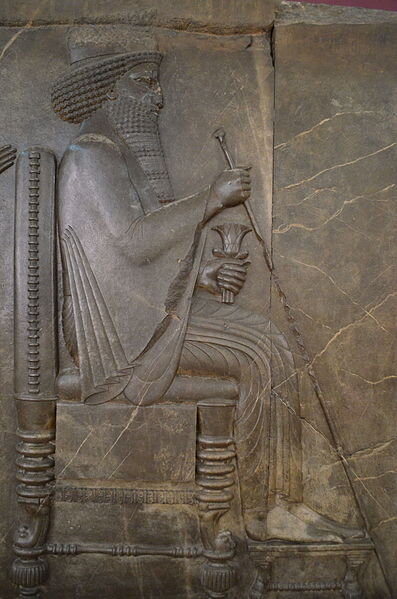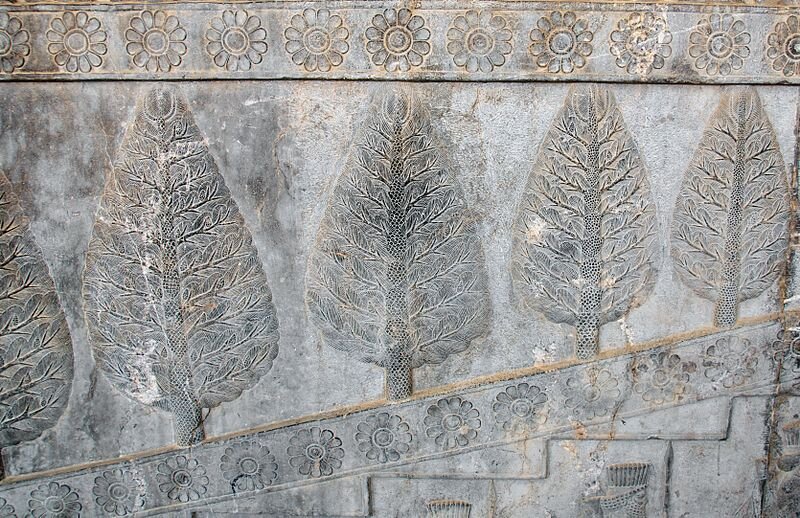The Persian Princess
Source: Wikipedia
The Achaemenid Falcon
The Persian Princess Mummy is a recently discovered mummy in Pakistan. Her discovery created excitement in the archaeological community as a Persian mummy has never been found. Script on her coffin led to the initial identification of that of King Xerxes I’s daughter, Rhodugune.
This initial announcement led to Iran, Afghanistan, and other parts of Pakistan to all claim ownership of the mummy.
Archaeologists in the National Museum in Karachi began to study the mummy only to discover a greater mystery than any they had imaged.
**Image rites are prohibitively expensive, in order to see what the mummy looks like, videos and links are provided.
Discovery
During the month of October in 2000, police in the city of Karachi in Pakistan were alerted to a video showing a mummy with an elaborate coffin for sale on the black market for millions of dollars. Fearing smuggling and art trafficking, the police raided the home of a man named Ali Akbar, who was in possession of the original video.
Akbar led the police to Wali Mohammad Reeki, a tribal leader and camel breeder, who lived in Quetta, Pakistan. At Reeki’s house, the police found the mummy. He had wanted up to a billion USD dollars for the mummy. Reeki and Akbar were arrested for crimes under Pakistan’s Antiquity Act (1975). Reeki admitted that a man named Sharif Shah Bakhi gave him the mummy. Bakhi was never found.
Ali Akbar told the police that the mummy had been discovered after an earthquake in the mountains at the border between Pakistan and Afghanistan displaced her coffin.
Quetta is the capital of the Balochistan province. It lies on the Afghanistan-Pakistan border.
Police brought the mummy back to Karachi. Dr. Asma Ibrahim, the Archaeology Museum in Karachi, was called in by the police. She took possession of the mummy for study.
Initial Attribution
The coffin was made from stone and was placed in a wooden box. It was elaborately carved and decorated. Ahura Mazda, a god figure from the Zoroastrian religion, was also carved into the wood.
The mummy wore an elaborate gold crown and gold mask. She rested on a reed mat. Her arms were crossed over her chest. Internal organs had been removed, similar to how the ancient Egyptians removed organs from their mummies. She was small, only 1.4 meters (4 feet and 7 inches) long.
The breastplate was inscribed with ancient Persian cuneiform script. The text from the breastplate said:
“I am the daughter of the great King Xerxes, Mazereka protect me, I am Rhodugune, I am.”
This was very exciting as King Xerxes is the most renowned ruler of the Achaemenid Empire (a Persian Empire). He rules from 486 to 465 B.C.E. If the mummy proved true, this would make her over 2600 years old. The fact that Persians did not mummify their dead royals created another unique aspect about Rhodugune’s mummy.
An initial press conference announced that the mummy might be a Persian princess dating to around 600 B.C.E.
Source:: Darafsh via Wikipedia.
A relief, most likely of Xerxes I , in the National Museum of Iran
Controversy of Ownership
With the preliminary identification suggesting the mummy might be a Persian princess, Iran claimed ownership. They demanded the mummy be returned from Pakistan. Iran believed that the mummy was smuggled into Pakistan.
Also contesting ownership was the Taliban from Afghanistan. They wondered if the mummy had been found in Afghanistan originally and suggested they might have a claim. Later, the Taliban spokesperson claimed that smugglers had admitted the mummy was found in the Afghan province of Nimroz, thus laying claim on the mummy.
Lastly, the Balochistan region of Pakistan were upset that the mummy had moved to the Sindh region (to Karachi). They felt that the mummy should be returned to Quetta.
Pakistan (specifically the Sindh region) reputed all other claims and continued their study of the mummy. In response, Iran threatened to file a claim with UNESCO and Interpol.
Scientific Analysis
The analysis of the mummy was carried out by a team of the National Museum in Pakistan, including the initial archaeologist and curator Dr. Asma Ibrahim. They planned on analyzing the cuneiform text, send the mummy for x-rays and CT scans, and perform radiocarbon dating of the objects buried with the mummy.
One quandary that the mummy presents is that mummies were used predominately by the ancient Egyptians and not the ancient Persians. Yet, if Rhodugune was buried by the Egyptians…why was cuneiform used and not hieroglyphics?
Identification of Rhodugune was going to be difficult. There is not much known about Rhodugune to begin with. If the archaeologists could prove this mummy was Rhodugune, it would be important as there have never been any remains discovered of the Persian royals. Her mummy was sent to a hospital in Karachi for an X-ray. The x-ray put the age of the mummy at death around 21-25 years of age. A CT scan would show if the organs had been removed in the ancient Egyptian fashion.
Certain motifs, like the seven cypress trees or rosettes, can be seen in decoration. Both are ancient symbols seen in Persian art as places like Persepolis in Iran.
Source: A Davey via Wikipedia
This image shows stylized trees and flowers from Apadana Staircase in Persepolis, Iran.
Forgery
While certain aspects of the mummy pointed to an authentic archaeological find, other facets were causing worry for Dr. Ibrahim. They reached out to the international community to verify certain items to decide once and for all.
The reed mat that the body was resting on was sent to Pakistan’s atomic energy commission which was able to date the mat aged no more than fifty years old. It was a modern creation. Radiocarbon dating suggested that the victim had died in 1996.
The jewelry found on the body was thin and cheap. This was at odds for a rich Persian princess, daughter of the great King Xerxes. The gold was so delicate that they would bend and twist when touched. When they were able to study the mummy’s hair, scientists discovered that her hair had been dyed with modern chemicals to fade it to look ancient.
Source: Nickmard Khoey via Wikipedia.
Cuneiform inscriptions at Persepolis, Iran.
The varnish that was found on the coffin was dated to a modern concoction, only thirty years old at most. Pencil marks were found on the coffin, showing where to cut and engrave (pencils were invented two hundred years ago). The linens that wrapped the mummy were new and the honey that was dripped upon the mummy was fresh.
The CT scan and further study discovered the heart was removed from the body. If the ancient Egyptians had mummified a royal body, they would not have removed the heart. The CT scan also showed ligaments. This meant the body could not be an ancient mummy as ligaments would have disintegrated.
The cuneiform was also an issue. The issue of cuneiform over hieroglyphs always bothered the Pakistan team so they reached out to an expert from American University. Grammatical errors, hinting at a modern creation, abound. One is that the name on the breastplate claims that the name of the mummy is Rhodugune—a later Greek name. In her own time, Xerxes’ daughter would have gone by her Persian name--Wardegauna.
On 17 April 2001, the team concluded their investigation. Dr. Asma Ibrahim issued a report with all their findings. She ultimately concluded that the Persian Princess was a modern-day fraud, created for the six billion USD black-market antiquity trade.
Murder (?) and Aftermath
The conclusion of the mummy being a forgery gave new meaning to the state of the body. It was concluded that the cause of death was a broken neck and that she was mummified within 24 hours of her death. It could be possible that she was murdered for the forgers to have a fresh body. It is also possible that she was a victim of a grave robber after dying in an accident.
Pakistani police began their murder inquiry. No identification has been declared. It was later discovered that two additional “Persian mummies” were being offered for sale in the, probably by the same team of expert fraudsters that created the first mummy.
The body was taken by the Edhi Foundation, a Pakistani charity, who was able to bury her in 2008.
The video (top) as a text with images as well.
Works Cited:
Brodie, Neil. “Persian Mummy.” Trafficking Culture. 2012.
Cowie, Ashley. “Mummy Cold Case: Tracing the Identity of the ‘Persian Princess’.” Ancient Origins. 2021.
Hasan, Shazia. “Archaeologist Narrates Tale of fake Persian Mummy.” Dawn. 2017.
Khan, Aamer Ahmed. “Burial for Pakistan’s Fake Mummy.” BBC. 2005.
Koenig, Robert. “Modern Mummy Mystery.” Science. 2001.
Naqvi, Abbas. “Fake ‘Mummy’ Still Awaits Burial.” BBC. 2008.
Raza, Fawwad. “Unraveling the Mystery of the Persian Princess-Murder Victim.” Scientia Magazine: Pakistan. 2021.
Romey, Kristin, and Mark Rose. “Special Report: Saga of the Persian Princess.” Archaeology. 2001.
Stolze, Dolly. “A Mummy Hoax might be wrapped up in a modern murder.” Atlas Obscura. 2014.
Unknown. Fakes and Forgeries. Igloo. 2008.
Unknown. “Iran Demands the Return of Mummy.” BBC. 2000.
Unknown. “Row over mystery mummy.” BBC. 2000.
Unknown. “The Mystery of the Persian Mummy.” Horizons. BBC. 2001.







